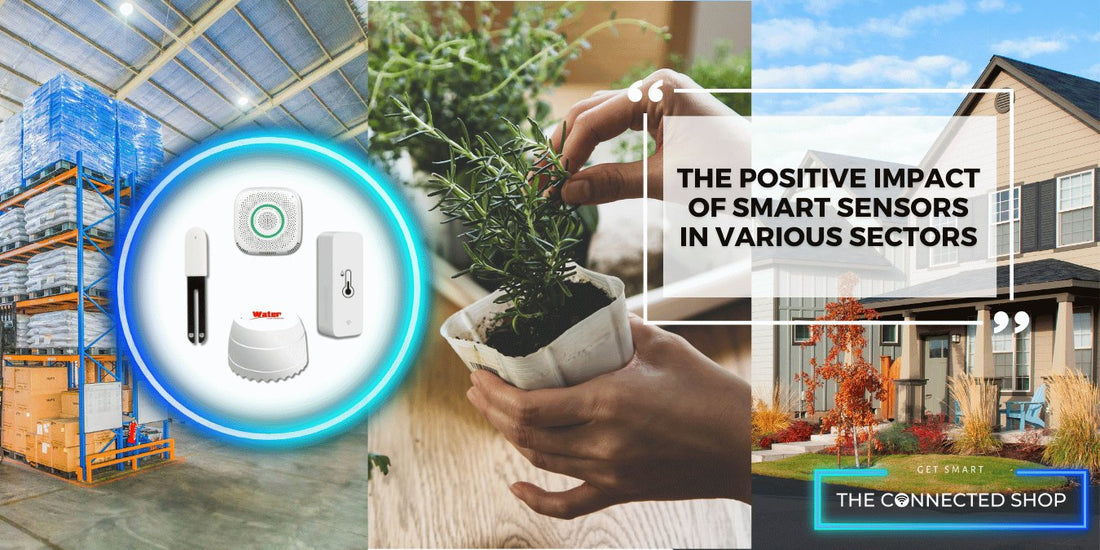Smart sensors are changing the way we live, work, and grow our food, becoming essential tools in our everyday lives. Imagine a home that not only keeps you comfortable by maintaining the perfect temperature but also alerts you to a water leak before it causes major damage or detects harmful gasses, keeping your family safe. Picture an indoor garden
where plants thrive because they’re given just the right amount of light and water, thanks to real-time data from smart sensors. Or think of a factory where machinery runs smoothly and efficiently because smart sensors catch potential issues before they cause costly breakdowns.
These innovative devices are more than just gadgets—they’re helping us create smarter, safer, and more efficient environments in our homes, gardens, and workplaces. As technology continues to evolve, smart sensors are becoming even more powerful, offering greater control and peace of mind. Dive into this article to discover how smart sensors are transforming our lives, making everyday tasks easier and more secure.
Understanding Smart Sensors: How They Work and Their Impact
Smart sensors are powerful devices designed to collect data from the environment, process it, and transmit it for further analysis or action. Unlike traditional sensors, which only detect changes, smart sensors have built-in computing capabilities that enable them to filter, store, and analyze the data they collect. This advanced functionality allows for more efficient data management, reducing the amount of information that needs to be transmitted, conserving bandwidth, and speeding up response times.
At the core of a smart sensor are several key components:
- Sensing Element: This is the part of the sensor that detects physical or chemical changes in the environment, such as temperature fluctuations, the presence of water, or the detection of harmful gasses.
- Microprocessor: The microprocessor processes the data collected by the sensing element, enabling the sensor to analyze the information and determine the appropriate action or response.
- Communication Module: Once the data is processed, the communication module transmits it to other devices or systems, either locally or through cloud-based platforms, where it can be further analyzed or used to trigger specific actions.
Smart sensors in a wide range of applications, from monitoring temperature and humidity levels in industrial settings to enhancing home safety by detecting water leaks, harmful gasses, and other potential hazards. Their ability to provide real-time insights and automate responses makes them invaluable in modern homes and industries alike. As technology continues to evolve, smart sensors are expected to play an increasingly important role in making our environments more responsive, efficient, and safe.
Applications of Smart Sensors Across Various Sectors: Enhancing Efficiency and Innovation
Smart sensors are transforming industries by providing advanced capabilities that enable more efficient, accurate, and responsive operations. Their versatility and adaptability make them indispensable across a variety of sectors. Below is a detailed look at how different industries are leveraging smart sensors and the primary features that make these devices so valuable.
Residential Sector: Enhancing Home Security and Safety with Smart Sensors
In the residential sector, where homeowners prioritize security and safety, smart sensors have become essential tools for safeguarding properties and preventing potential hazards. As homes become more connected, the role of these intelligent devices in ensuring a safe and secure living environment has grown significantly.
Primary Features:
- Door and Window Sensors: Smart sensors on doors and windows are crucial for enhancing home security. These sensors can detect when a door or window is opened, sending instant alerts to homeowners via their smartphones or home security systems. In the event of unauthorized access, the system can trigger alarms, activate security cameras, or even notify local authorities. This immediate response capability is vital in preventing break-ins and ensuring the safety of residents.
- Motion Detection: Smart motion detectors are another key component of a comprehensive home security system. These devices can detect movement in and around the home, distinguishing between everyday activities and potential threats. For instance, they can differentiate between a pet moving through a room and a person attempting to enter the house. When suspicious activity is detected, the system can respond by turning on lights, activating cameras, or sending alerts to the homeowner. This real-time monitoring adds an extra layer of protection, making it more difficult for intruders to go unnoticed.
- Water Leak Sensors: Water damage is one of the most common and costly issues faced by homeowners. Smart water leak sensors are designed to detect even the smallest leaks before they escalate into major problems. These sensors can be placed in vulnerable areas such as under sinks, near water heaters, or in basements. When a leak is detected, the sensor can alert the homeowner and, in some cases, automatically shut off the water supply to prevent further damage. This proactive approach helps protect homes from the extensive damage and expensive repairs associated with water leaks.
Additional Benefits:
- Peace of Mind: For homeowners, the peace of mind that comes from knowing their home is protected by smart sensors is invaluable. Whether they are at work, on vacation, or just asleep at night, these sensors provide continuous monitoring and instant alerts, ensuring that any potential security or safety issues are addressed immediately.
- Cost Savings: While the initial investment in smart sensors may seem significant, the long-term cost savings can be substantial. Preventing break-ins, water damage, or other emergencies not only protects the home but also reduces insurance premiums and avoids costly repairs.
Smart sensors in the residential sector are more than just a luxury; they are a necessity for homeowners who are particularly sensitive to security and safety concerns. With the ability to detect and respond to potential threats and hazards, these devices provide a robust defense against a wide range of risks, ensuring that homes remain safe, secure, and well-protected. As the technology continues to evolve, the capabilities of smart sensors will only increase, offering even greater protection and convenience for homeowners.
Smart Sensors in Agriculture: Revolutionizing Indoor Gardening and Farming
As indoor gardening and farming gain popularity for their efficiency and feasibility, smart sensors are playing a critical role in optimizing these environments. These advanced devices are helping upstart, modern farmers and gardeners achieve better control over their plants, ensuring they receive the precise care they need to thrive. With the rise of urban farming and the need for sustainable food production, smart sensors are becoming indispensable tools in modern agriculture.
Primary Features:
- Plant and Flower Sensors: Indoor gardening and farming require meticulous attention to the needs of each plant. Smart sensors for plants and flowers can monitor critical factors such as soil moisture, temperature, light levels, and nutrient content. These sensors provide real-time data, enabling gardeners to adjust conditions instantly to ensure optimal growth. For instance, if a sensor detects that a plant is not receiving enough light, it can trigger grow lights to activate or suggest repositioning the plant. This level of precision is particularly important in controlled environments where every variable can impact the success of a crop.
- Smart Water Tank Level Sensors: Efficient irrigation is essential in indoor farming, where water use must be carefully managed. Smart water tank level sensors monitor the water levels in storage tanks, ensuring that irrigation systems have a steady supply. These sensors can alert farmers when water levels are low, preventing interruptions in irrigation that could stress plants. Additionally, they can be integrated with automated irrigation systems to adjust watering schedules based on the needs of the plants, optimizing water use and promoting healthy growth.
Additional Benefits:
- Resource Efficiency: Smart sensors help indoor gardeners and farmers make the most of their resources. By providing detailed insights into the specific needs of each plant, these sensors minimize waste and reduce the need for guesswork. This not only conserves water and energy but also ensures that plants receive exactly what they need to flourish, leading to higher yields and better-quality produce.
- Sustainability: Indoor farming, supported by smart sensor technology, is a more sustainable approach to agriculture. By reducing water use, minimizing waste, and optimizing resource management, these systems contribute to a more environmentally friendly way of growing food. This is particularly important as the global population increases and the demand for sustainable food production methods grows.
Smart sensors are transforming indoor gardening and farming by providing the precise data needed to optimize plant care. From monitoring soil conditions to ensuring a steady water supply, these devices enable gardeners and farmers to create the perfect environment for their crops. As the trend towards indoor farming continues to rise, the role of smart sensors will only become more significant, offering a high-tech solution to the challenges of modern agriculture. With their ability to enhance efficiency, improve plant health, and support sustainable practices, smart sensors are set to play a crucial role in the future of food production.
Manufacturing and Industrial Automation: Ensuring Safety and Efficiency with Smart Sensors
The manufacturing and industrial sectors are increasingly relying on smart sensors to enhance productivity, ensure safety, and reduce operational costs. In these highly sophisticated environments, where precision and safety are paramount, smart sensors like gas leak detectors play a critical role in maintaining safe and efficient operations.
Primary Features:
- Gas Leak Detection: In industrial environments, the presence of hazardous gases can pose serious risks to both personnel and equipment. Smart sensors designed to detect gas leaks are vital for ensuring safety. These sensors continuously monitor the air for dangerous levels of gases such as carbon monoxide, methane, or volatile organic compounds (VOCs). When a potential leak is detected, the sensor can immediately trigger alarms, shut down equipment, or activate ventilation systems to prevent accidents and ensure worker safety. This real-time detection capability is essential in preventing catastrophic incidents, reducing downtime, and maintaining a safe working environment.
- Humidity Level Monitoring: Maintaining the proper humidity level is critical in many industrial workspaces, particularly in sectors like electronics manufacturing, pharmaceuticals, and food production. Excessive humidity can lead to equipment malfunctions, product degradation, and even promote the growth of mold or corrosion. Smart air sensors allow for precise control of moisture levels in the air, ensuring that conditions remain within the optimal range. By continuously monitoring and adjusting humidity, these sensors help protect sensitive equipment and products, reduce energy consumption in climate control systems, and prevent costly damages that can arise from poor humidity management.
- Energy Management: In addition to safety and maintenance, smart sensors contribute to energy efficiency by optimizing the consumption of electricity, water, and other resources. By monitoring and adjusting energy use in real time, these sensors help manufacturers reduce their environmental footprint and achieve significant cost savings. This is particularly important in industries where energy-intensive processes are common, and even small efficiencies can lead to substantial financial benefits.
Conclusion
Smart sensors are revolutionizing key sectors by delivering real-time data that boosts safety, efficiency, and convenience. In homes, they monitor temperature, humidity, water leaks, and hazardous gasses, ensuring comfort and security while preventing costly issues. In indoor farming, these sensors optimize growing conditions, leading to higher yields and sustainable practices. In industry, smart sensors enhance safety by detecting gas leaks, managing energy use, and protecting equipment. As technology advances, smart sensors are becoming indispensable tools, driving innovation and creating smarter, safer, and more efficient environments.








